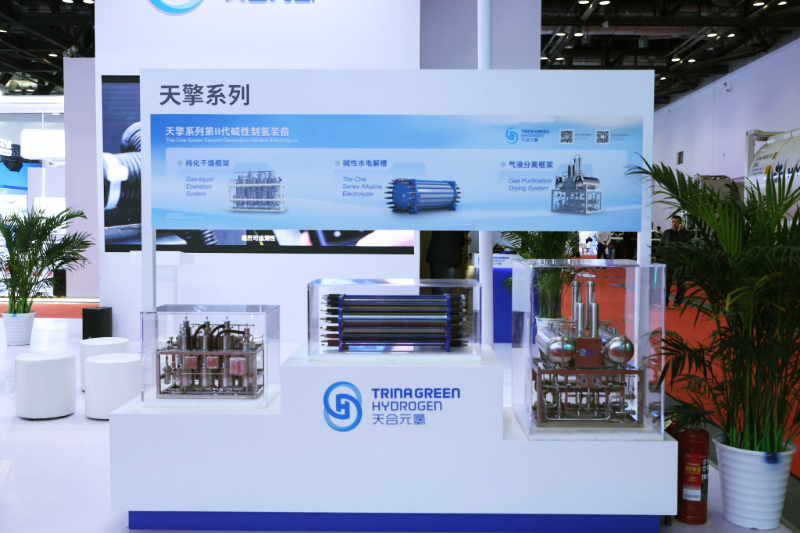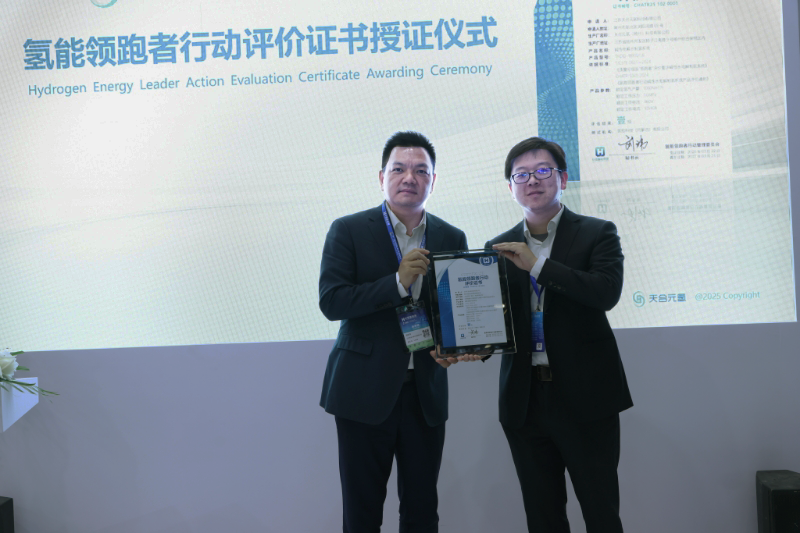On March 26th, Trina Green Hydrogen made its debut at the 4th China International Hydrogen and Fuel Cell Industry Exhibition, launching its independently developed "Tianqing Series Second Generation Alkaline Electrolysis Water Hydrogen Production Equipment".

As one of the world's largest manufacturers of electrolytic water hydrogen production equipment, Trina Green Hydrogen's new generation products, with "safer, more stable, more efficient, and more economical" as the core, break through the technological bottleneck in large-scale hydrogen production scenarios, provide core equipment support for the large-scale development of green hydrogen, and further consolidate its leading position in the field of hydrogen energy equipment.
Iterative Upgrade: Four Major Performance Breakthroughs Refactoring Industry Standards

At present, large-scale hydrogen production projects face numerous problems, such as operational issues caused by frequent start-up and shutdown of wind and solar power equipment to adapt to fluctuations, gas purity issues caused by long-term operation, leakage issues that may occur under high electrical density conditions, and energy consumption degradation issues caused by electrode material lifespan. The second-generation thousand square meter alkali tank launched by Trina Green Hydrogen can fully solve these industry pain points through material optimization, structural optimization, and the addition of intelligent monitoring.
1. Excellent start stop efficiency: In actual testing, the Tianqing second-generation product can achieve a 5% adjustment rate, and cold start only takes 104 seconds to reach the rated current density, achieving the rated hydrogen production and ensuring load following source movement. The wide load adjustment range of 20% -130% is more adaptable to fluctuating electricity, and even under ultra-low load conditions, the hydrogen concentration in oxygen is only 1.54%.
2. Low DC energy consumption: The rated current density of the second-generation slot has been increased to 4000A/㎡, and the DC power consumption under 100% load conditions is 3.898kWh/Nm ³. Using high-performance electrode materials, the electrochemical performance is stable through ultrasonic peeling experiments, durability tests, and constant current tests. The electrode weight loss rate is less than 4%, the voltage decay rate is less than 0.2%, and the range ratio is less than 4%. The electrode material is efficient and stable.
3. Stable operation status: Through simulation analysis of the flow field and thermal field of the tank, the flow channel design has been optimized to make the environment inside the tank more uniform and stable, reduce the loss of materials such as membranes and electrodes, ensure the stable operation of the electrolytic cell, ensure no leakage or short circuit, and ensure stable and safe operation status.
4. Better economy: The number of electrolytic cell chambers has been reduced from 319 to 230, equipment weight has been reduced by nearly 10%, volume has been reduced by 21.9%, equipment costs have been reduced by 30%, and breakthroughs in DC power consumption have been made. The use of Trina Green Hydrogen second-generation thousand cubic meter alkali tanks can improve the economy of large-scale green hydrogen projects.

The Tianqing second-generation equipment has achieved a comprehensive upgrade from equipment performance to system collaboration through three core technological breakthroughs: electrode material innovation, flow field simulation optimization, and intelligent control algorithms. The key performance of the equipment has been certified by both the Hydrogen Alliance Leader Action and DeKai Quality. Our goal is to reduce the cost of green hydrogen through intelligent equipment and help achieve the 'dual carbon' goal, "said Duan Shunwei, President of Trina Green Hydrogen, at the exhibition site
Building a zero carbon industry chain driven by both production capacity and technology
The Tianqing second-generation equipment released this time is based on the fully automated production line manufacturing of Trina Green Hydrogen Yangzhou Intelligent Production Base, integrating digital and intelligent technologies to achieve industry-leading performance indicators.
On October 28, 2024, Trina Green Hydrogen, the world's largest production base for electrolytic water hydrogen equipment, was completed and put into operation at its research and development base in Yangzhou. The first phase of the project will build a 1GW alkaline electrolytic water hydrogen equipment production line, with a planned future production capacity of 4GW.
At present, Trina Green Hydrogen has formed a dual line layout covering alkaline (ALK) and proton exchange membrane (PEM) technologies. The ALK production line adopts an intelligent weld seam tracking system, which improves welding efficiency by 30% and achieves industry-leading product consistency. At the same time, the company is accelerating the research and development of PEM technology and plans to promote the construction of the second phase production line according to market demand. As an important part of Trina Solar's zero carbon industry chain of "photovoltaics+energy storage+hydrogen energy", Trina Green Hydrogen achieves efficient consumption and storage of new energy electricity through its "integrated photovoltaics and hydrogen storage" solution.
Industry outlook: Green hydrogen costs enter a downward trend
Currently, the cost of hydrogen production through electrolysis of water in China is about 30-40 yuan/kg. Trina Green Hydrogen has reduced the ALK equipment cost by 15% compared to the industry average through large-scale production and technological iteration. With the continuous decrease in the cost of wind and solar power generation and the coordinated optimization of the industrial chain, it is expected that the cost of green hydrogen will be reduced to below 20 yuan/kg by 2025, forming competitiveness with grey hydrogen.
Trina Green Hydrogen President Duan Shunwei said, "We will continue to increase research and development investment, deepen cooperation in the entire industry chain of 'production, storage, transportation, and use', and through intelligent equipment innovation and business model exploration, make green hydrogen truly the core carrier of energy transformation
Faced with challenges such as limited application scenarios for hydrogen energy and the need to improve the industrial chain, Trina Green Hydrogen calls for policy support and industry collaboration to jointly promote the large-scale implementation of hydrogen energy in transportation, chemical industry, energy storage and other fields, making green hydrogen a universal energy source.




